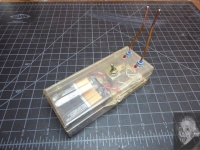Back in the 70s when I was starting to get involved with integrated circuits* I had a source of cheap scrapped electronic boards. I would buy them and desolder and reuse the components. Of course, this involved a lot of component testing (after all, the boards had been scrapped for a reason) and identification since components often had only manufacturer markings.
When I saw a design for a diode polarity/condition tester in an electronics magazine, I set to work to make one immediately. This photo...
shows the finished product housed in a plastic box. Inside the box is this circuit...
The op amp is wired as a square wave oscillator whose output swings from almost full positive to full negative with respect to ground. If a good diode is connected with its cathode end attached to 'A' the left hand LED is forward biased and will light. If the cathode end is connected to 'B', the right hand LED will light. Judicious placement of the LEDs relative to the test contacts will allow the lighted LED to indicate either the cathode or anode of the diode under test. (My version is set to indicate the anode.)
The device also indicates diode condition. If both LEDs light, the diode is shorted. If neither lights, the diode is open. In either case, discard it.
Although overkill, it's also good for testing fuses. A good fuse lights both LEDs, an open one lights neither.
Yes, there are many other ways to test diodes. But, if you have a bunch, this thing will relieve a lot of the tedium.
--
* Integrated circuits were a huge boon for me. As an undergrad physics student, we had to take a one semester electronics course. It was electronics for people who were not going to become electronic engineers but still needed to build and, more importantly, understand test equipment for experiments. Needless to say, it was very basic. It might help you to understand how an op-amp works but you would never be able to build one based on what you had learned there.
Integrated circuits changed all that. All of a sudden it was black box engineering. You didn't need to know what went on in the chip. Just hook modules together to obtain the desired effect. (Well, at least at the hobby level; for stuff that was going to fly we called in the EEs.)



 LinkBack URL
LinkBack URL About LinkBacks
About LinkBacks




 Reply With Quote
Reply With Quote


Bookmarks